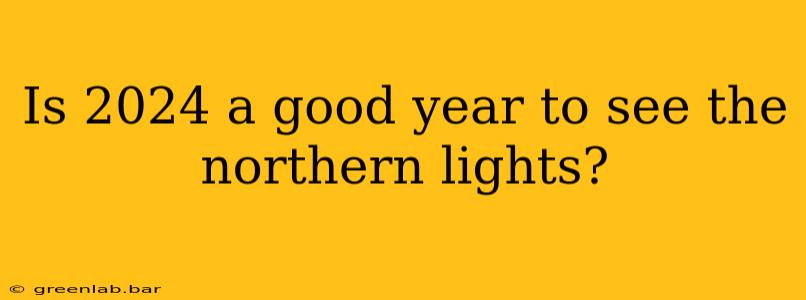The Northern Lights, or Aurora Borealis, are a breathtaking natural phenomenon captivating skywatchers worldwide. But seeing this celestial dance depends on several factors, making the question "Is 2024 a good year?" more nuanced than a simple yes or no.
The Solar Cycle and Aurora Activity
The key to predicting aurora activity lies in the solar cycle. This 11-year cycle sees the Sun's activity fluctuate, from periods of solar minimum (low activity) to solar maximum (high activity). More solar activity generally translates to a higher chance of seeing the Northern Lights. We're currently moving towards solar maximum, which is predicted to peak around 2025. This means 2024 sits in a sweet spot, offering a potentially good window of opportunity for aurora viewing. While we won't experience the peak intensity of 2025, the increasing solar activity in 2024 should provide more frequent and potentially more vibrant displays.
Other Factors Influencing Aurora Visibility
While the solar cycle is crucial, other factors significantly impact your chances of witnessing the aurora:
1. Geomagnetic Storms:
These powerful disturbances in the Earth's magnetosphere are triggered by solar activity and are directly responsible for the intensity of the aurora. Stronger geomagnetic storms lead to more visible and widespread auroral displays, even at lower latitudes. Monitoring space weather forecasts, readily available online, is essential for planning your aurora viewing trip. Websites and apps dedicated to space weather provide real-time updates on geomagnetic activity.
2. Location and Light Pollution:
Your location is paramount. You need dark skies far from city lights. Popular aurora viewing locations include Alaska, Canada, Iceland, Norway, Sweden, Finland, Greenland, and even parts of Scotland. Researching specific locations within these regions, prioritizing areas with minimal light pollution, is vital for maximizing your chances.
3. Time of Year and Time of Night:
The aurora is visible year-round, but your chances are significantly higher during the winter months (September to April) when the nights are long and dark. The optimal viewing time is typically between 10 PM and 2 AM.
4. Weather Conditions:
Clear skies are absolutely essential. Clouds will completely obscure the aurora. Checking weather forecasts before heading out is just as crucial as monitoring space weather predictions.
So, is 2024 a good year?
Based on the current trajectory of the solar cycle, 2024 presents a favorable opportunity to see the Northern Lights. The increasing solar activity increases the likelihood of auroral displays. However, remember that success hinges on several factors beyond the solar cycle. Thorough planning, including monitoring space weather forecasts and choosing a location with minimal light pollution and clear skies, is key to maximizing your chances of witnessing this incredible natural spectacle. Don't just rely on the year; plan strategically to dramatically increase your chances of experiencing the magic of the Aurora Borealis.

